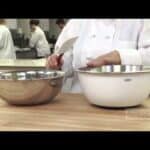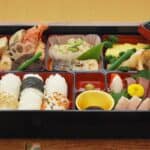No kitchen is complete without a set of mixing bowls. And to choose…
…the right mixing bowls materials is important. Whether for stirring ingredients, marinating foods for the grill, storing leftovers, organizing measured amounts of ingredients before embarking on a complicated recipe or even serving a salad or another dish, you’ll find yourself reaching for your mixing bowls time and again.
With a wide range of sizes, materials, and prices, how do you choose which ones are best for you? If your space and budget permits, it’s actually handy to have a wide range of sizes and types of bowls. The smallest bowls can hold one cup or less, perfect for beating a single egg or holding a portion of ingredients ready to be mixed into a recipe.
And you’ll find bowls as large as 6 or 7 quarts, which might not be needed on a daily basis, but are certainly handy for entertaining or stirring up multiple batches of cookie dough. For most households, an assortment of five bowls ranging from 2 cups to 4 or 5 quarts in capacity should be sufficient. If you are looking for the best mixing bowls for bread making, we have a recommendation for you!
There are several common materials typically used to make mixing bowls, each with their own set of advantages and disadvantages. The following is a roundup of the most popular types of mixing bowls, and what you need to know about them. Here are some options for mixing bowls once you’ve decided what types of bowls you need.
Mixing Bowls Materials: Glass
- In addition to being nonreactive, glass doesn’t react with chemicals, so food won’t taste, look, or feel differently. It’s microwaveable, and some tempered glass bowls are more durable and can be used in the oven or freezer. Tempered glass is made with certain materials and a heating and cooling process that make it more durable and temperature-resistant, and it breaks into pebbles of glass rather than shards when broken.
- cons : Even tempered glass is susceptible to breaking when dropped. What’s more, glass can be sensitive to changes in temperature. It’s also difficult to beat egg whites into foam in glass bowls, as the sides of the bowl are too slippery.
- Buying tip: Look for glass bowls with features such as measurement markings, lids, and pour spouts.
Mixing Bowls Materials: Metal
- Pros: Easily available at restaurant supply stores or well-stocked kitchenware stores, metal mixing bowls are generally inexpensive, ultra-durable, and versatile. A bowl the right size can function as a double boiler (choose one that nestles inside a saucepan but doesn’t quite reach the bottom. The bowls are lightweight, making them ideal for elderly or disabled people.
- Con: If the thin metal is holding hot liquid, it can get very hot. Some people might find that metal bowls have a sterile, industrial look to be a drawback. If you repeatedly scrape too hard against the bottom or side of the bowl when beating egg whites or whipping cream, your mixture may turn gray or have a metallic taste.
- Buying tip: If you can, use stainless steel rather than aluminum, which may react adversely with foods, especially acidic ones like tomatoes.
Mixing Bowls Materials: Ceramic
- Ceramic mixing bowls are very attractive because they come in a wide range of beautiful colors. Additionally, you can find some with raised patterns sculpted on their sides, as well as stripes and other designs painted on their surfaces, making them suitable for serving as well. You can stir them on your counter with minimal movement, and some are microwave- and oven-safe.
- Cons: Ceramics are prone to chipping, cracking, and breaking.
- You should choose high-fired ceramics, which are more durable than earthenware ceramics. Some dinnerware patterns even offer mixing bowl sets as part of their line extension.
Mixing Bowls Materials: Copper
- Pros: Copper bowls are the best vessel for beating egg whites. Tiny quantities of copper ions react with the egg to stabilize the mixture.
- Cons: They are among the most expensive bowls available.
- Buying tip: If you beat a lot of egg whites by hand, buy one copper bowl especially for that purpose and buy the rest of your bowls in another material.
Mixing Bowls Materials: Plastic
- Pros: They’re lightweight, inexpensive, and virtually unbreakable, so they’re ideal for transporting salads and other dishes to picnics and potlucks.
- Some plastics can melt when they come in contact with hot surfaces. In addition, some plastic can absorb odors like garlic or stain when they contact it.
- Buying tip: You can often find mixing bowl sets that come with lids for storage.
Mixing Bowls Materials: Wood/Natural
- Bowls made of bamboo, cork, or wood feature an attractive, natural look. Also, there is nothing better for making a salad than a wooden bowl; the wood gets seasoned with time and adds flavor to each salad.
- Cons: You may not be able to mix dough or batter on a smooth, nonporous surface made of wood, for instance.
- Buying tip: Choose a shallow bowl that has a capacity of 4 or 5 quarts to prepare your salad, and rub mineral oil into it if it becomes dry.
Mixing Bowls Materials: Silicone
- The pros of silicone include its temperature-proof properties, nonstick properties, ease of cleaning, collapsibility, and virtually indestructibility. They can be microwaved and washed in the dishwasher. You can even pinch them slightly to produce a pouring spout because they’re flexible.
- Silicone has a swishy, rubbery texture that not everyone likes. In addition, silicone retains the odor of pungent foods.
- Buying tip: Especially convenient are small silicone pinch bowls, just the right size for holding small amounts of ingredients while you’re cooking, like salt, spices, and minced herbs.
Was this helpful?
Hi there! I’m a food enthusiast and journalist, and I have a real passion for food that goes beyond the kitchen. I love my dream job and I’m lucky enough to be able to share my knowledge with readers of several large media outlets. My specialty is writing engaging food-related content, and I take pride in being able to connect with my audience. I’m known for my creativity in the kitchen, and I’m confident that I can be the perfect guide for anyone looking to take their culinary journey to the next level.








